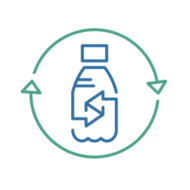Overview
PFAS (per- and polyfluoroalkyl substances) are a large class of man-made fluorinated chemicals added to plastics and other materials to impart water and stain resistance. But they are toxic, persistent, and associated with many health risks.
Found in Products
PFAS are used in the following types of plastic and consumer products:
Food packaging – Added to paper food packaging like fast food wrappers and microwave popcorn bags to make them grease-resistant.
Non-stick cookware – PFAS used to coat non-stick pans and baking trays.
Stain-resistant fabrics – Used to treat carpets, upholstery, outdoor gear, and clothing like rainjackets.
Personal care items – Found in cosmetics, dental floss, shampoos.
Cleaning products – Added to waxes, polishes, and household cleaners.
Building materials – Used to weatherproof outdoor materials.
Electronics – Applied as coatings on cellphones, laptops, wires.
Firefighting foam – PFAS-based foams used to douse fuel fires.
Associated Risks
Here are some of the key health effects that have been associated with PFAS exposure:
Liver toxicity – PFAS exposure has been linked to liver damage and altered liver enzyme levels in human studies.
Thyroid hormone disruption – PFAS reduce thyroid hormone levels and alter metabolism.
Lower antibody response to vaccines – Higher PFAS exposure in children correlates with reduced immune response to tetanus and diphtheria vaccines.
Developmental effects – Prenatal PFAS exposure correlated with lower birth weight, reduced growth, and neurobehavioral effects in children.
Cancer – Increased risk of certain cancers like kidney, testicular and bladder cancers observed in highly exposed populations.
Cholesterol changes – Linked to increased total cholesterol and LDL cholesterol.
Immune system effects – May alter immune cell populations and increase risk of infections.
Reproductive toxicity – Altered reproductive hormone levels and reduced fertility associated with PFAS exposure.
How To Avoid
Here are some tips to avoid exposure to PFAS chemicals:
- Avoid grease/oil resistant paper food packaging like microwave popcorn bags, fast food wrappers. Choose unlined paper bags.
- Use stainless steel or cast iron cookware instead of “non-stick” coated pans. Avoid scratches.
- Read clothing labels and opt for PFAS-free waterproof outerwear. Choose cotton, wool, and other natural fabrics.
- Avoid cosmetics and dental floss containing PFAS. Check ingredients for “PTFE” and “fluoro”.
- Use waxes, polishes, cleaners, etc. confirmed not to contain PFAS.
- Install filters certified to remove PFAS on drinking water sources contaminated above advisory levels.
- Avoid carpets, upholstery, mattresses treated with stain protectants which can contain PFAS.
- Support transitioning to fluorine-free firefighting foams to prevent environmental contamination.
- Advocate for regulations on PFAS use and labeling requirements for PFAS-containing products.
While ubiquitous, informed purchasing decisions and policy changes to restrict PFAS can help lower exposures from sources like food packaging, textiles, cosmetics, and cookware.
